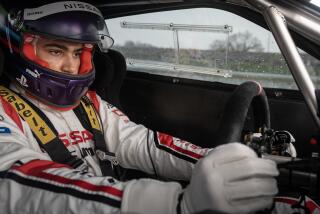Carmakers stretch mileage of product placement deals
In a battle near the end of box-office smash âIron Man,â the villain is stomping on the hero when an Audi R8 smashes into the bad guy, knocking him off balance and allowing Iron Man to escape.
For Audi, the scene was a dream, a chance for its new sports car to shine in a protagonistâs role. Unfortunately, it ended up on the cutting room floor, and since Audi had signed on to spend big bucks promoting the movie with advertising and a website -- not to mention lending the production a lot of cars (including two R8s that were wrecked) -- something had to be done to keep the Germans happy.
The solution: a drawn-out shot of an Audi Q7 sport utility vehicle being saved by Iron Man himself, complete with a sustained full-frontal of Audiâs four-ring logo.
âThey agreed to make us comfortable with what we were getting,â said Arden Doss, managing director of Propaganda, a product placement firm that coordinates Audiâs film and television deals.
Movies and TV shows are packed with placements of products as diverse as soap and soda, but the tango between car companies and Hollywood is increasingly intimate. Most big films these days, including âWantedâ (Chrysler) and âThe Dark Knightâ (Lamborghini), have significant car placements, and television shows such as âWeedsâ (Toyota) and âDamagesâ (General Motors) build similar relationships.
Nearly all carmakers have their own product placement firms, keep fleets of cars available for productions that need them (GM has nearly 400 on hand) and wine and dine directors and producers in hopes of convincing them that their model is perfect for, as itâs known in the biz, the âhero carâ role.
âCar deals are big money,â said LeeAnne Stables, head of worldwide marketing partnerships for Paramount, which co-produced âIron Manâ along with Marvel Films.
Surprisingly, very little money changes hands. Instead of cutting checks, the auto industry has learned to help with production costs, lending vehicles to studios for use on camera, for transportation and, as was the case for âIron Man,â even for chauffeured rides to the premiere party.
And, most important, Hollywood leans on carmakers to help with marketing. âItâs no longer, âHereâs $50,000, get my car in a background shot,â â said Frank Zazza, founder and chief executive of ITVX, which measures and rates product placements. âNow you negotiate a package of advertising, marketing, space on your website, and, in exchange, the product is in the picture.â
Carefully selecting the cars in movies is nothing new. In the 1930s, Warner Bros. had a deal with Buick to put its cars in movies such as the Busby Berkeley musical âGold Diggers.â But it was more recent placements like 1990âs âThe Rookie,â in which Clint Eastwood crashes a Mercedes 500SL through a window and then spits out the slogan, âEngineered like no other car in the world,â that gave placements a bad name.
âSometimes they backfire,â said Jason Squire, film professor at USCâs School of Cinematic Arts, pointing out that the audience can be turned off to both movie and product if the placement is heavy-handed. âItâs a real judgment call.â
Mercedes hopes it judged right in New Lineâs âSex and the City,â which brought in $56 million at the box office in its opening weekend. In exchange for a shot of Mr. Big riding in an S-Class sedan and Samantha climbing into an as-yet-unreleased GLK compact SUV, Mercedes-Benz undertook the costly task of re-creating New Yorkâs fashion week, which it sponsors in real life, for a single scene.
Ferdinand Froning, head of Mercedesâ entertainment liaison office, said New Line approached him about the movie. The original script called for an S-Class. When New Line asked about a joint marketing campaign, the carmaker politely suggested that the GLK get screen time too. âWe watched the dailies and saw it was there,â Froning said. âThen we started talking seriously about marketing.â
Although some TV placements, such as a slot under Adrian Grenierâs posterior on âEntourage,â canât be bought at any price -- HBO doesnât take payment for product placement and doesnât have any marketing deals with carmakers -- many are highly negotiable.
When NBC recently decided to revive âKnight Rider,â several companies were contacted about providing the vehicle for the role of Knight Industries Three Thousand. Though KITT was a Pontiac Trans Am in the original series, it was Ford that offered the sweetest deal this time.
Not only would Ford make several custom Mustangs, at no small cost, but it also would use its significant budget allocation for network advertising to scratch NBCâs back. âWas there a major financial moment? There had to be,â said Bob Witter, global brand entertainment manager for Ford, explaining that Ford traded its media buy for screen presence. â âKnight Riderâ is the ultimate role. Thatâs hero plus, plus, plus.â
Not every role is starring, but for a slot on the right project carmakers are all too happy to lend vehicles even for supporting parts.
Volvo has been lending vehicles, free, to ABCâs âDesperate Housewivesâ for some time, taking them back at seasonâs end. When a 2007 episode called for Teri Hatcherâs character to drive the car into a lake, Robin March, Volvoâs fleet manager at the time for such placements, gritted her teeth. Lending a car is one thing; destroying it is considerably more costly.
Ultimately, Volvo greenlighted the dunking. âThey redid the scene three times, crashing the car into the lake each time,â March said. âBut if itâs a good enough placement, no problem.â
Perhaps more than any other carmaker, General Motors positively blankets TV and the silver screen with placements. For âTransformers,â which Dino Bernacchi, director of marketing alliances and branded entertainment for GM, calls âthe Holy Grail,â the auto giant pulled out all the stops.
In addition to a massive global marketing campaign, the production had the use of 65 vehicles, which director Michael Bay at the time estimated were worth $3 million, including the as-yet-unreleased Chevrolet Camaro.
âThe car didnât even exist yet. We built two of them from the ground up,â Bernacchi said, adding that GM was in discussions to play an equally large role in âTransformers 2.â
The enormous success of that film, which earned $707 million at the box office worldwide, made it an unmatchable promotional tool for GM, Bernacchi said. And GMâs investment guaranteed car shots that looked, at times, more like commercials than anything else.
Thatâs why brands such as Hyundai, which havenât historically played the product placement game, are now interested. This month, the South Korean automaker said it had hired Davie Brown Entertainment to get product placement for its new Genesis luxury car.
âWeâre going to do a pretty broad outreach program,â said Bob Schneider, executive vice president at Davie Brown. âItâll take about a month to take the Genesis around to all the production companies, TV shows and movie studios.â
--






